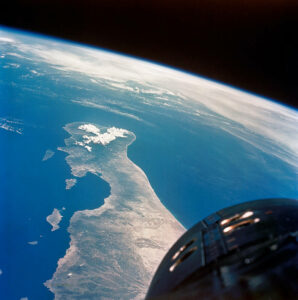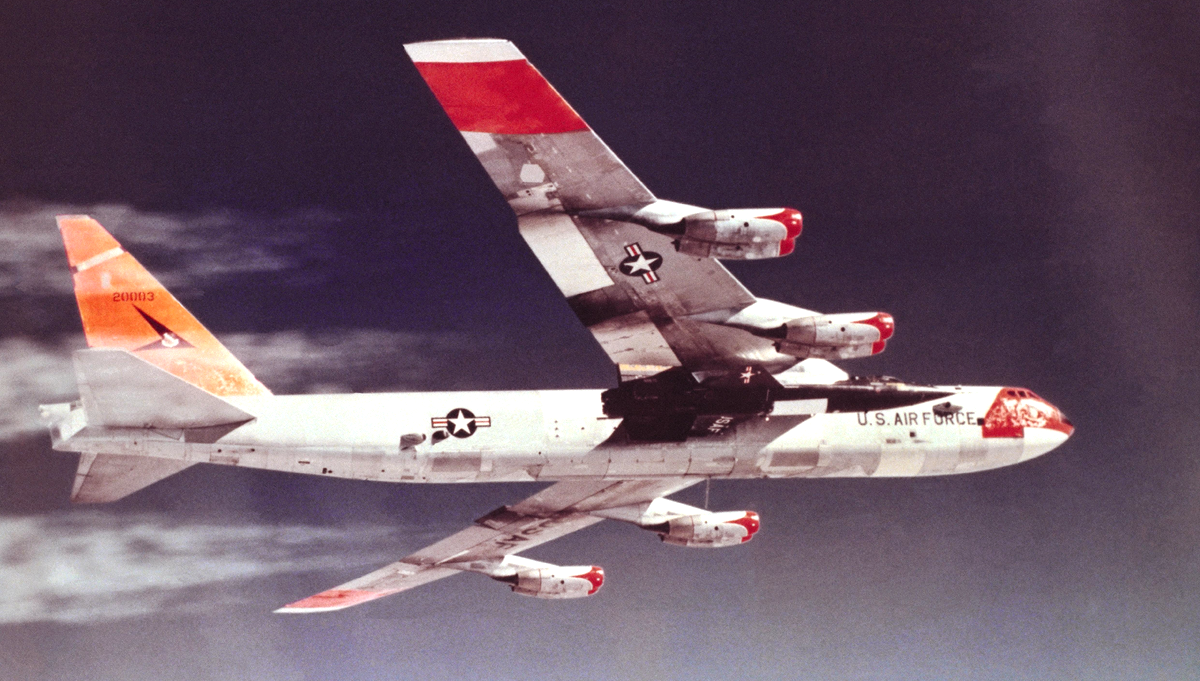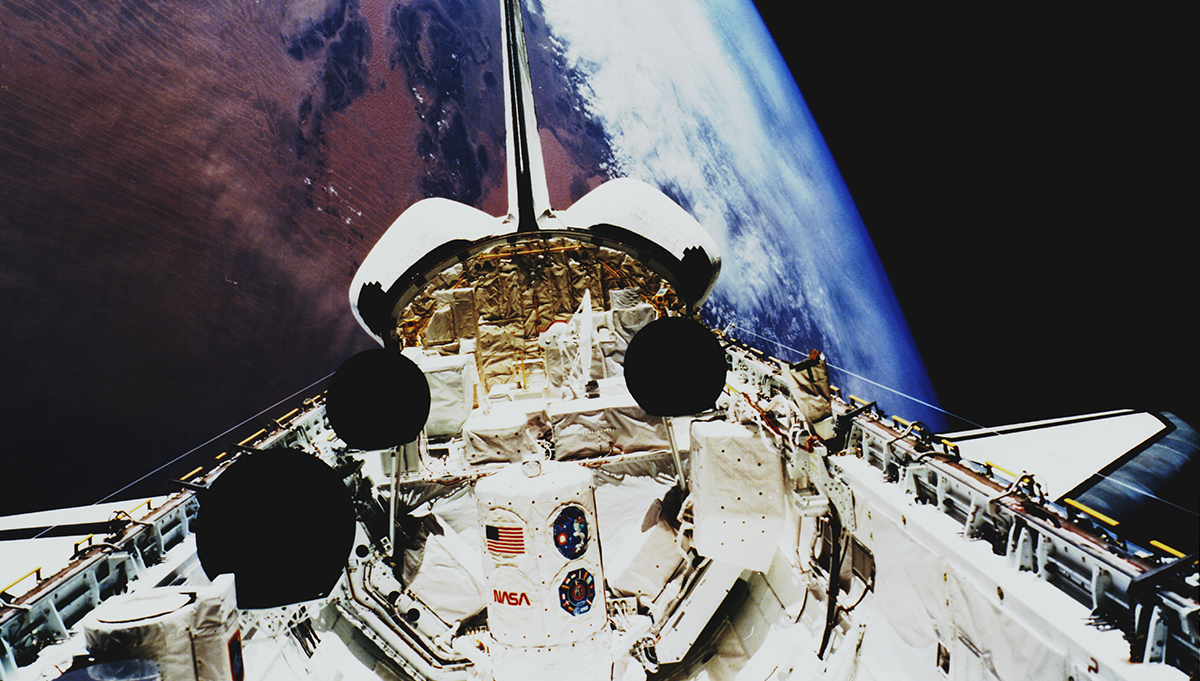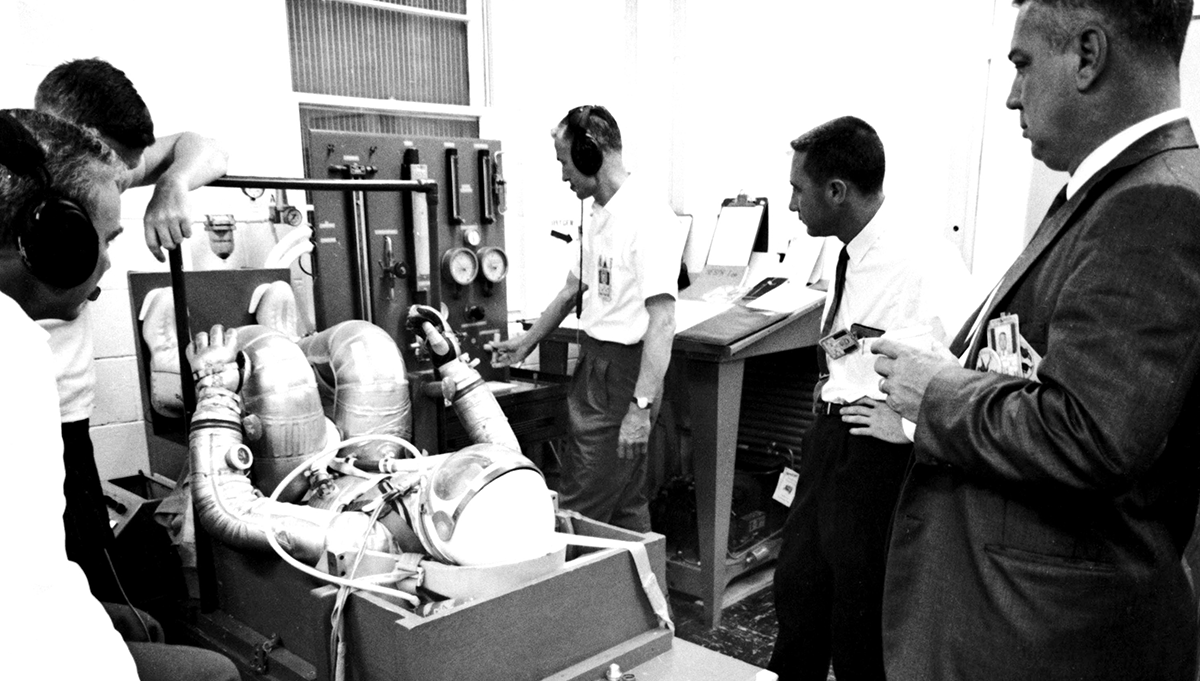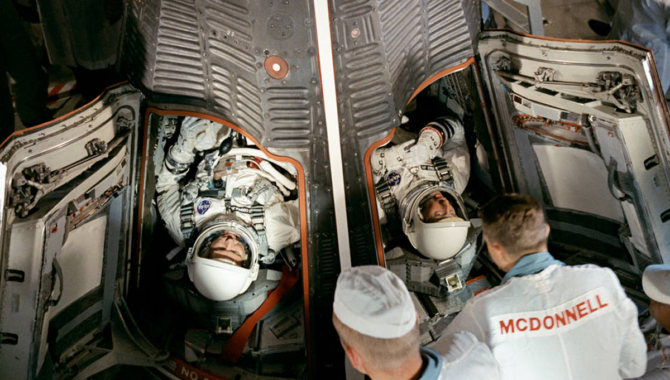
Workers in the White Room at Launch Pad 19 help L. Gordon Cooper, Jr., left, and Charles “Pete” Conrad strap in to Gemini V. The two would share the record for longest spaceflight for about four months.
Photo Credit: NASA
Record-setting mission carries new technologies.
In January 1959, L. Gordon Cooper, Jr. reported to his commander’s office at Edwards Air Force Base. Cooper was a project manager working on experimental flight tests and very happy in his job when he received orders to report to Washington, D.C.
“No explanation or anything,” Cooper recalled in an oral history. “In fact, there were three of us from the base [who] were leaving, [who] were ordered to report to Washington. And our commander called us in and said, ‘Do you have any idea what this is about?’ We said, ‘No, sir. We don’t.’ He said, ‘Well, I don’t either.’ But he said, ‘Don’t go volunteering for anything foolish.’”
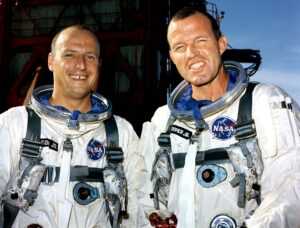
Gemini V pilot Charles “Pete” Conrad, left, and command pilot L. Gordon Cooper, Jr. stand in front of Cape Kennedy’s Launch Pad 19 during a training exercise on Aug. 16, 1965.
Photo Credit: NASA
Cooper, who recalled that he was unaware the U.S. was developing a space program at the time, soon learned that he was a potential candidate to be one of NASA’s first astronauts. Following a day of briefings, he committed wholeheartedly. On April 9, 1959, Cooper was named one of the first seven U.S. astronauts.
Six years later, on a bright August morning on Florida’s Space Coast 58 years ago this month, Cooper was strapped into the commander’s seat of Gemini V, beside pilot Charles “Pete” Conrad. The cabin was a tight fit, with astronauts comparing it to a phone booth. This was the third crewed mission in Project Gemini, with a series of ambitious goals that included remaining in space for eight days, the target duration for a first mission to the Moon.
The capsule was “… absolutely crammed with equipment of all kinds… We had the first fuel cell. We had the first radar. We had the first all-up computer. These were all things that needed to be tested and proven. And we had some 20 some-odd cameras of different types and several hundred rolls of film of different kinds. And one of the things that needed to be tested was going the full eight days,” Cooper recalled.

Artist concept of a two-man Gemini spacecraft with a cutaway view of the interior.
Illustration Credit: NASA
On a mission filled with emerging technology, going the full eight days wasn’t a foregone conclusion. Soon after reaching orbit, while ejecting a pod for a rendezvous exercise, the astronauts saw that pressure was dropping in the oxygen tank of Gemini V’s fuel cell. Fuel cells were one of the early engineering challenges of Project Mercury, and a key to an eventual mission to the Moon, which would be beyond the capacity of traditional batteries. Fuel cells can continue to generate electricity through a chemical reaction as long as they can be supplied liquid hydrogen and liquid oxygen.
“Yeah, right off the bat, we had the oxygen pressure drop to practically zero. By all the ground rules, I had to go into total power down. So, we powered everything down, brought everything down to low, low electrical power; and, of course, it happened again when we were out of radio range. So, as we came whistling over the horizon into communication, Houston realized we were all powered down and they really panicked there for a moment; and it looked like we were going to have to reenter another orbit later,” Cooper said.
Fortunately, the team had tested a similar scenario in an altitude chamber at McDonnell Aircraft Corporation’s facilities in St. Louis days before the capsule was shipped to Florida to be paired with a Titan II rocket for launch preparation.
“…If we had not done that test, we would have reentered an orbit later. But because we had done the test, we knew the fuel cell would run at lower pressures, so we decided to try it for a while and baby it, and see if we could get the pressure back up. And a few orbits later, we began to get indications that we were going to get the fuel cell back online,” Cooper recalled.

Panoramic view of the Mission Control room at NASA’s Manned Spacecraft Center (now Johnson Space Center) during the Gemini 5 mission.
Photo Credit: NASA
Teams at Mission Control led by Flight Director Christopher C. Kraft were able to resolve the pressure issues with the oxygen tank, enabling the team to power up the capsule and return to a packed schedule that included photographing Earth, five medical experiments and seven technological demonstrations. The original mission plan called for the astronauts to sleep in shifts, but they soon learned that wasn’t going to work.
“Well, theoretically, it seemed like it made a lot of sense that, if one could work while the other slept, we were going to get a lot more work done,” Cooper said. “But in the real, live world, it didn’t seem to work that way because all of a sudden on the normal diurnal cycle, which we still were acclimatized to, we came whistling over the horizon, both of us asleep. So, after a little debate between us and the ground, we decided we’d reset the schedules.”
Having lost the opportunity to rendezvous with the pod that was ejected early in the mission, Mission Control devised a simulated rendezvous in which the astronauts used the radar and computer to move to a specific point in space as if the pod were there, gathering important data for future missions.
Gemini V returned to Earth on August 29, 1965, splashing down in the Atlantic Ocean, about 80 miles short of the target point because of a programming error in the capsule’s computer. Cooper became the first human to orbit the Earth on multiple spaceflights. Cooper and Conrad shared the record for longest spaceflight until December, when Gemini VII astronauts Frank F. Borman II and James A. Lovell Jr. spent 14 days in space.
It was the last spaceflight for Cooper, who flew Mercury-Atlas 9 in November 1962. He retired from NASA on July 31, 1970. Conrad was the Commander of Gemini XI and Apollo 12, which was struck by lightning during the November 14, 1969 launch. Conrad, who was about 5 feet 6 inches tall, became the third human to step on the Moon, joking, “Whoopee! Man, that may have been a small one for Neil, but that’s a long one for me.”






